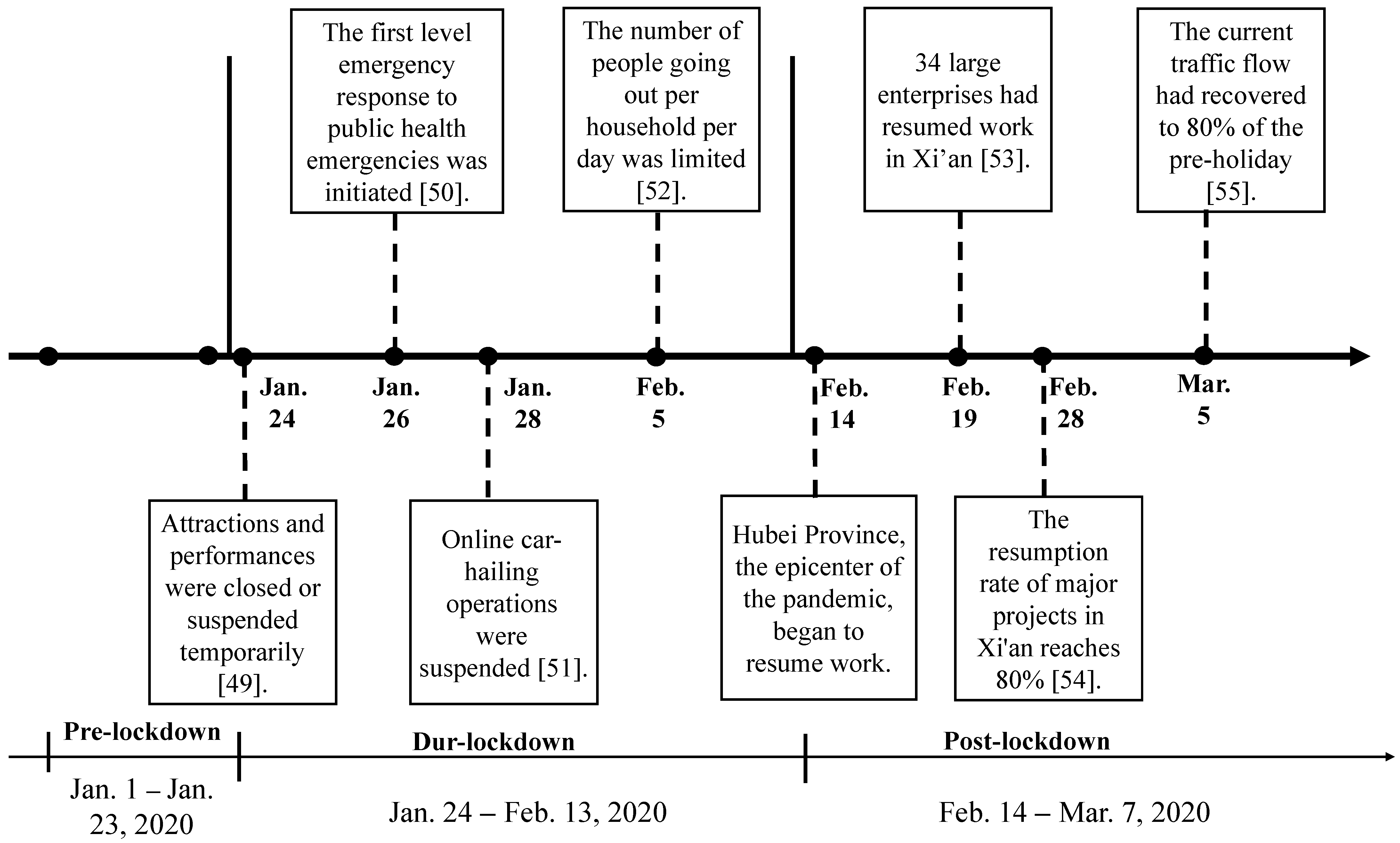Quantifying Air Pollutant Variations during COVID-19 Lockdown in a Capital City in Northwest China
Abstract
1. Introduction
2. Materials and Methods
2.1. Experimental Design
2.2. PM2.5 Sample Collection
2.3. Gravimetric and Chemical Analyses
2.4. Online Data Collection
3. Results and Discussion
3.1. AQI and Online Six National Controlled Air Pollutants
3.2. PM2.5 from Offline Filter Samples
3.3. OC and EC Characteristics in PM2.5 Filter Samples
3.4. WSIs in PM2.5 Filter Samples
3.5. Comparison of Air Quality during the COVID-19 Lockdown among Studies
4. Conclusions
Author Contributions
Funding
Institutional Review Board Statement
Informed Consent Statement
Data Availability Statement
Acknowledgments
Conflicts of Interest
References
- Liu, H.; Wu, B.; Liu, S.; Shao, P.; Liu, X.; Zhu, C.; Wang, Y.; Wu, Y.; Xue, Y.; Gao, J.; et al. A regional high-resolution emission inventory of primary air pollutants in 2012 for Beijing and the surrounding five provinces of North China. Atmos. Environ. 2018, 181, 20–33. [Google Scholar] [CrossRef]
- Zhang, H.; Yin, S.; Bai, L.; Lu, X.; Wang, C.; Gu, X.; Li, Y. Establishment and evaluation of anthropogenic black and organic carbon emissions over Central Plain, China. Atmos. Environ. 2020, 226. [Google Scholar] [CrossRef]
- Jiang, P.; Chen, X.; Li, Q.; Mo, H.; Li, L. High-resolution emission inventory of gaseous and particulate pollutants in Shandong Province, eastern China. J. Clean. Prod. 2020, 259. [Google Scholar] [CrossRef]
- Zhong, Z.; Zheng, J.; Zhu, M.; Huang, Z.; Zhang, Z.; Jia, G.; Wang, X.; Bian, Y.; Wang, Y.; Li, N. Recent developments of anthropogenic air pollutant emission inventories in Guangdong province, China. Sci. Total. Environ. 2018, 627, 1080–1092. [Google Scholar] [CrossRef] [PubMed]
- Huneeus, N.; Denier van der Gon, H.; Castesana, P.; Menares, C.; Granier, C.; Granier, L.; Alonso, M.; de Fatima Andrade, M.; Dawidowski, L.; Gallardo, L.; et al. Evaluation of anthropogenic air pollutant emission inventories for South America at national and city scale. Atmos. Environ. 2020, 235. [Google Scholar] [CrossRef]
- Le, T.; Wang, Y.; Liu, L.; Yang, J.; Yung, Y.L.; Li, G.; Seinfeld, J.H. Unexpected air pollution with marked emission reductions during the COVID-19 outbreak in China. Science 2020, 369, 702–706. [Google Scholar] [CrossRef] [PubMed]
- Ghaffarpasand, O.; Nadi, S.; Shalamzari, Z.D. Short-term effects of anthropogenic/natural activities on the Tehran criteria air pollutants: Source apportionment and spatiotemporal variation. Build. Environ. 2020, 186. [Google Scholar] [CrossRef]
- Dotse, S.-Q.; Dagar, L.; Petra, M.I.; De Silva, L.C. Evaluation of national emissions inventories of anthropogenic air pollutants for Brunei Darussalam. Atmos. Environ. 2016, 133, 81–92. [Google Scholar] [CrossRef]
- Zhang, Y.; Zhu, X.; Slanina, S.; Shao, M.; Zeng, L.; Hu, M.; Bergin, M.; Salmon, L. Aerosol pollution in some Chinese cities (IUPAC Technical Report). Pure Appl. Chem. 2004, 76, 1227–1239. [Google Scholar] [CrossRef]
- Xu, H.; Cao, J.; Chow, J.C.; Huang, R.J.; Shen, Z.; Chen, L.W.; Ho, K.F.; Watson, J.G. Inter-annual variability of wintertime PM2.5 chemical composition in Xi’an, China: Evidences of changing source emissions. Sci. Total Environ. 2016, 545–546, 546–555. [Google Scholar] [CrossRef]
- Feng, T.; Bei, N.; Zhao, S.; Wu, J.; Liu, S.; Li, X.; Liu, L.; Wang, R.; Zhang, X.; Tie, X.; et al. Nitrate debuts as a dominant contributor to particulate pollution in Beijing: Roles of enhanced atmospheric oxidizing capacity and decreased sulfur dioxide emission. Atmos. Environ. 2021, 244. [Google Scholar] [CrossRef]
- Guo, Z.; Guo, Q.; Chen, S.; Zhu, B.; Zhang, Y.; Yu, J.; Guo, Z. Study on pollution behavior and sulfate formation during the typical haze event in Nanjing with water soluble inorganic ions and sulfur isotopes. Atmos. Res. 2019, 217, 198–207. [Google Scholar] [CrossRef]
- Singh, A.K.; Srivastava, A. Seasonal Trends of Organic and Elemental Carbon in PM1 Measured over an Industrial Area of Delhi, India. Aerosol Sci. Eng. 2021, 5, 112–125. [Google Scholar] [CrossRef]
- Rajput, P. OM/OC Ratio of Polar and Non-Polar Organic Matter during Wintertime from Indo-Gangetic Plain: Implications to Regional-Scale Radiative Forcing. Aerosol Sci. Eng. 2018, 2, 153–164. [Google Scholar] [CrossRef]
- Qiao, Q.; Huang, B.; Piper, J.D.A.; Biggin, A.J.; Zhang, C. The characteristics of environmental particulate matter in the urban area of Beijing, China, during the 2008 Olympic Games. Atmos. Pollut. Res. 2017, 8, 141–148. [Google Scholar] [CrossRef]
- Wang, S.; Zhao, M.; Xing, J.; Wu, Y.; Zhou, Y.; Lei, Y.; He, K.; Fu, L.; Hao, J. Quantifying the air pollutants emission reduction during the 2008 Olympic Games inBeijing. Environ. Sci. Technol. 2010, 44, 2490–2496. [Google Scholar] [CrossRef]
- Cheng, Y.F.; Heintzenberg, J.; Wehner, B.; Wu, Z.J.; Hu, M.; Mao, J.T. Traffic restrictions in Beijing during the Sino-African Summit 2006: Aerosol size distribution and visibility compared to long-term in situ observations. Atmos. Chem. Phys. Discuss. 2008, 8, 12971–12998. [Google Scholar] [CrossRef]
- Huang, K.; Zhuang, G.; Lin, Y.; Wang, Q.; Fu, J.S.; Fu, Q.; Liu, T.; Deng, C. How to improve the air quality over mega-cities in China?—Pollution characterization and source analysis in Shanghai before, during, and after the 2010 World Expo. Atmos. Chem. Phys. Discuss. 2013, 13, 3379–3418. [Google Scholar] [CrossRef]
- Huang, K.; Zhang, X.; Lin, Y. The “APEC Blue” phenomenon: Regional emission control effects observed from space. Atmos. Res. 2015, 164–165, 65–75. [Google Scholar] [CrossRef]
- Wang, P.; Chen, K.; Zhu, S.; Wang, P.; Zhang, H. Severe air pollution events not avoided by reduced anthropogenic activities during COVID-19 outbreak. Resour. Conserv. Recycl. 2020, 158, 104814. [Google Scholar] [CrossRef] [PubMed]
- World Health Organization. Available online: https://www.who.int/emergencies/diseases/novel-coronavirus-2019/interactive-timeline (accessed on 29 April 2021).
- World Health Organization. Available online: https://covid19.who.int/ (accessed on 11 April 2021).
- Sun, Z.; Zhang, H.; Yang, Y.; Wan, H.; Wang, Y. Impacts of geographic factors and population density on the COVID-19 spreading under the lockdown policies of China. Sci. Total. Environ. 2020, 746, 141347. [Google Scholar] [CrossRef] [PubMed]
- Xi’an Municipal People’s Government. Available online: http://www.xa.gov.cn/sq/csgk/rkzk/5d4907af65cbd87465a5f024.html (accessed on 29 April 2021).
- COVID-19 Global Confirmation/Cure/Death Increase and Growth Trend Graph. Available online: https://www.jisilu.cn/question/347815 (accessed on 29 April 2021).
- Xi’an National Aviation Industry Base. Available online: https://baijiahao.baidu.com/s?id=1661600744376930281&wfr=spider&for=pc (accessed on 29 April 2021).
- Xi’an Municipal Bureau of Statistics. Available online: http://tjj.xa.gov.cn/tjsj/tjsj/jdsj/2020n/5e8fd8ccfd85080ad1363e5d.html (accessed on 29 April 2021).
- Bhat, S.A.; Bashir, O.; Bilal, M.; Ishaq, A.; Din Dar, M.U.; Kumar, R.; Bhat, R.A.; Sher, F. Impact of COVID-related lockdowns on environmental and climate change scenarios. Environ. Res. 2021, 195, 110839. [Google Scholar] [CrossRef]
- Fernandes, N. Economic Effects of Coronavirus Outbreak (COVID-19) on the World Economy. SSRN Electron. J. 2020. [Google Scholar] [CrossRef]
- Caraka, R.E.; Lee, Y.; Kurniawan, R.; Herliansyah, R.; Kaban, P.A.; Nasution, B.I.; Gio, P.U.; Chen, R.C.; Toharudin, T.; Pardamean, B. Impact of COVID-19 large scale restriction on environment and economy in Indonesia. Glob. J. Environ. Sci. Manag. 2020, 6, 65–82. [Google Scholar]
- McKibbin, W.J.; Fernando, R. The Global Macroeconomic Impacts of COVID-19: Seven Scenarios. SSRN Electron. J. 2020. [Google Scholar] [CrossRef]
- Díaz, J.; Antonio-López-Bueno, J.; Culqui, D.; Asensio, C.; Sánchez-Martínez, G.; Linares, C. Does exposure to noise pollution influence the incidence and severity of COVID-19? Environ. Res. 2021, 195. [Google Scholar] [CrossRef] [PubMed]
- Caraka, R.E.; Yusra, Y.; Toharudin, T.; Chen, R.; Basyuni, M. Did Noise Pollution Really Improve during COVID-19 ? Evidence from Taiwan. Sustainability 2021, 13, 5946. [Google Scholar] [CrossRef]
- Lee, P.J.; Jeong, J.H. Attitudes towards outdoor and neighbour noise during the COVID-19 lockdown: A case study in London. Sustain. Cities Soc. 2021, 67, 102768. [Google Scholar] [CrossRef]
- Marinello, S.; Butturi, M.A.; Gamberini, R. How changes in human activities during the lockdown impacted air quality parameters: A review. Environ. Prog. Sustain. Energy 2021, e13672. [Google Scholar] [CrossRef]
- Kotnala, G.; Mandal, T.K.; Sharma, S.K.; Kotnala, R.K. Emergence of Blue Sky Over Delhi Due to Coronavirus Disease (COVID-19) Lockdown Implications. Aerosol Sci. Eng. 2020, 4, 228–238. [Google Scholar] [CrossRef]
- Zhang, J.; Li, H.; Lei, M.; Zhang, L. The impact of the COVID-19 outbreak on the air quality in China: Evidence from a quasi-natural experiment. J. Clean. Prod. 2021, 296, 126475. [Google Scholar] [CrossRef]
- Wyche, K.P.; Nichols, M.; Parfitt, H.; Beckett, P.; Gregg, D.J.; Smallbone, K.L.; Monks, P.S. Changes in ambient air quality and atmospheric composition and reactivity in the South East of the UK as a result of the COVID-19 lockdown. Sci. Total. Environ. 2021, 755, 142526. [Google Scholar] [CrossRef] [PubMed]
- Shen, L.; Wang, H.; Zhu, B.; Zhao, T.; Liu, A.; Lu, W.; Kang, H.; Wang, Y. Impact of urbanization on air quality in the Yangtze River Delta during the COVID-19 lockdown in China. J. Clean. Prod. 2021, 296. [Google Scholar] [CrossRef]
- Saxena, A.; Raj, S. Impact of lockdown during COVID-19 pandemic on the air quality of North Indian cities. Urban. Clim. 2021, 35. [Google Scholar] [CrossRef]
- Kumari, P.; Toshniwal, D. Impact of lockdown on air quality over major cities across the globe during COVID-19 pandemic. Urban. Clim. 2020, 34, 100719. [Google Scholar] [CrossRef] [PubMed]
- Bhuiyan, M.A.; An, J.; Mikhaylov, A.; Moiseev, N.; Danish, M.S.S. Renewable energy deployment and covid-19 measures for sustainable development. Sustainability 2021, 13, 4418. [Google Scholar] [CrossRef]
- Djalante, R.; Nurhidayah, L.; Lassa, J.; Minh, H.V.; Mahendradhata, Y.; Ngoc, N.T.; Trias, L.A.P.; Miller, A.M.; Djalante, S.; Sinapoy, M.S. The ASEAN’s responses to COVID-19: A policy sciences analysis. PsyArXiv 2020, 368. [Google Scholar] [CrossRef]
- Wang, W.; Liu, Y.; Zhang, L.; Ran, L.; Xiong, S.; Tan, X. Associations between Indoor Environmental Quality and Infectious Diseases Knowledge, Beliefs and Practices of Hotel Workers in Wuhan, China. Int. J. Environ. Res. Public Health 2021, 18, 6367. [Google Scholar] [CrossRef]
- Caraka, R.E.; Noh, M.; Chen, R.C.; Lee, Y.; Gio, P.U.; Pardamean, B. Connecting Climate and Communicable Disease to Penta Helix Using Hierarchical Likelihood Structural Equation Modelling. Symmetry 2021, 13, 657. [Google Scholar] [CrossRef]
- Sudiana, K.; Sule, E.T.; Soemaryani, I.; Yunizar, Y. The development and validation of the Penta Helix construct. Bus. Theory Pract. 2020, 21, 136–145. [Google Scholar] [CrossRef]
- Kabli, A.; Rizzello, A.; Trotta, A. Roadmapping new impact bonds in a post-covid world: Insights from case studies in the education sector. Sustainability 2021, 13, 4121. [Google Scholar] [CrossRef]
- Tomé, E.; Gromova, E. Development of emergent knowledge strategies and new dynamic capabilities for business education in a time of crisis. Sustainability 2021, 13, 4518. [Google Scholar] [CrossRef]
- 2020 Lunar New Year Xi’an Fireworks Prohibited and Restricted Area. Available online: http://xa.bendibao.com/news/2015210/50338.shtm (accessed on 29 April 2021).
- Health Commission of Shaanxi Province. Available online: https://mp.weixin.qq.com/s/7fH1fxka692Gxf9JUbbwyQ (accessed on 8 May 2021).
- Xi’an Transportation Bureau. Available online: https://www.sohu.com/a/369486225_70728 (accessed on 29 April 2021).
- Shaanxi Satellite TV. Available online: https://www.sohu.com/a/369486225_70728 (accessed on 8 May 2021).
- Shaanxi Satellite TV News. Available online: https://www.sohu.com/a/374197753_355338 (accessed on 29 April 2021).
- Xi’an National Aviation Industry Base. Available online: https://baijiahao.baidu.com/s?id=1659761830266859533&wfr=spider&for=pc (accessed on 8 May 2021).
- Summary of the Latest Information on the City’s Resumption of Work and Production. Available online: https://www.sohu.com/a/378414652_120214191 (accessed on 8 May 2021).
- Cao, J.J.; Wu, F.; Chow, J.C.; Lee, S.C.; Li, Y.; Chen, S.W.; An, Z.S.; Fung, K.K.; Watson, J.G.; Zhu, C.S.; et al. Characterization and source apportionment of atmospheric organic and elemental carbon during fall and winter of 2003 in Xi’an, China. Atmos. Chem. Phys. 2005, 5, 3127–3137. [Google Scholar] [CrossRef]
- Xu, H.; Guinot, B.; Shen, Z.; Ho, K.; Niu, X.; Xiao, S.; Huang, R.-J.; Cao, J. Characteristics of Organic and Elemental Carbon in PM2.5 and PM0.25 in Indoor and Outdoor Environments of a Middle School: Secondary Formation of Organic Carbon and Sources Identification. Atmosphere 2015, 6, 361–379. [Google Scholar] [CrossRef]
- Shen, Z.; Cao, J.; Liu, S.; Zhu, C.; Wang, X.; Zhang, T.; Xu, H.; Hu, T. Chemical composition of PM10 and PM2.5 collected at ground level and 100 meters during a strong winter-time pollution episode in Xi’an, China. J. Air. Waste. Manag. Assoc. 2011, 61, 1150–1159. [Google Scholar] [CrossRef]
- China National Environmental Monitoring Centre. Available online: http://www.cnemc.cn (accessed on 29 April 2021).
- Air Quality Online Monitoring and Analysis Platform. Available online: https://www.aqistudy.cn/historydata/monthdata (accessed on 29 April 2021).
- Huang, C.; Wang, T.; Niu, T.; Li, M.; Liu, H.; Ma, C. Study on the variation of air pollutant concentration and its formation mechanism during the COVID-19 period in Wuhan. Atmos. Environ. 2021, 251, 118276. [Google Scholar] [CrossRef]
- Marinello, S.; Lolli, F.; Gamberini, R. The Impact of the COVID-19 Emergency on Local Vehicular Traffic and Its Consequences for the Environment: The Case of the City of Reggio Emilia (Italy). Sustainability 2020, 13, 118. [Google Scholar] [CrossRef]
- Zambrano-Monserrate, M.A.; Ruano, M.A.; Sanchez-Alcalde, L. Indirect effects of COVID-19 on the environment. Sci. Total Environ. 2020, 728, 138813. [Google Scholar] [CrossRef]
- Ministry of Ecology and Environment of the People’s Republic of China. GB 3095-2012. Ambient Air Quality Standard; China Environmental Science Press: Beijing, China, 2018; p. 3. [Google Scholar]
- Xu, H.; Li, Y.; Feng, R.; He, K.; Ho, S.S.H.; Wang, Z.; Ho, K.F.; Sun, J.; Chen, J.; Wang, Y.; et al. Comprehensive characterization and health assessment of occupational exposures to volatile organic compounds (VOCs) in Xi’an, a major city of northwestern China. Atmos. Environ. 2021, 246, 118085. [Google Scholar] [CrossRef]
- Yang, L.; Shen, Z.; Wang, D.; Wei, J.; Wang, X.; Sun, J.; Xu, H.; Cao, J. Diurnal variations of size-resolved bioaerosols during autumn and winter over a semi-arid megacity in northwest China. GeoHealth 2021, 5. [Google Scholar] [CrossRef] [PubMed]
- Sulaymon, I.D.; Zhang, Y.; Hopke, P.K.; Zhang, Y.; Hua, J.; Mei, X. COVID-19 pandemic in Wuhan: Ambient air quality and the relationships between criteria air pollutants and meteorological variables before, during, and after lockdown. Atmos. Res. 2021, 250, 105362. [Google Scholar] [CrossRef]
- Shehzad, K.; Xiaoxing, L.; Ahmad, M.; Majeed, A.; Tariq, F.; Wahab, S. Does air pollution upsurge in megacities after Covid-19 lockdown? A spatial approach. Environ. Res. 2021, 197, 111052. [Google Scholar] [CrossRef]
- Gray, H.A.; Cass, G.R. Characteristics of atmospheric organic and elemental carbon particle concentrations in Los Angeles. Environ. Sci. Technol. 1986, 20, 580–589. [Google Scholar] [CrossRef]
- Xu, H.; Guinot, B.; Cao, J.; Li, Y.; Niu, X.; Ho, K.F.; Shen, Z.; Liu, S.; Zhang, T.; Lei, Y.; et al. Source, health risk and composition impact of outdoor very fine particles (VFPs) to school indoor environment in Xi’an, Northwestern China. Sci. Total. Environ. 2018, 612, 238–246. [Google Scholar] [CrossRef]
- Cao, J.J.; Chow, J.C.; Watson, J.G.; Wu, F.; Han, Y.M.; Jin, Z.D.; Shen, Z.X.; An, Z.S. Size-differentiated source profiles for fugitive dust in the Chinese Loess Plateau. Atmos. Environ. 2008, 42, 2261–2275. [Google Scholar] [CrossRef]
- Zhang, T.; Cao, J.J.; Chow, J.C.; Shen, Z.X.; Ho, K.F.; Ho, S.S.; Liu, S.X.; Han, Y.M.; Watson, J.G.; Wang, G.H.; et al. Characterization and seasonal variations of levoglucosan in fine particulate matter in Xi’an, China. J. Air. Waste. Manag. Assoc. 2014, 64, 1317–1327. [Google Scholar] [CrossRef] [PubMed]
- Shen, Z.; Cao, J.; Arimoto, R.; Han, Z.; Zhang, R.; Han, Y.; Liu, S.; Okuda, T.; Nakao, S.; Tanaka, S. Ionic composition of TSP and PM2.5 during dust storms and air pollution episodes at Xi’an, China. Atmos. Environ. 2009, 43, 2911–2918. [Google Scholar] [CrossRef]
- Feng, R.; Xu, H.; He, K.; Wang, Z.; Han, B.; Lei, R.; Ho, K.F.; Niu, X.; Sun, J.; Zhang, B.; et al. Effects of domestic solid fuel combustion emissions on the biomarkers of homemakers in rural areas of the Fenwei Plain, China. Ecotox. Environ. Safe. 2021, 214, 112104. [Google Scholar] [CrossRef] [PubMed]
- He, K.; Xu, H.; Feng, R.; Shen, Z.; Li, Y.; Zhang, Y.; Sun, J.; Zhang, Q.; Zhang, T.; Yang, L.; et al. Characteristics of indoor and personal exposure to particulate organic compounds emitted from domestic solid fuel combustion in rural areas of northwest China. Atmos. Res. 2021, 248. [Google Scholar] [CrossRef]
- Zhang, Q.; Shen, Z.; Cao, J.; Ho, K.; Zhang, R.; Bie, Z.; Chang, H.; Liu, S. Chemical profiles of urban fugitive dust over Xi’an in the south margin of the Loess Plateau, China. Atmos. Pollut. Res. 2014, 5, 421–430. [Google Scholar] [CrossRef]
- Shen, Z.; Arimoto, R.; Cao, J.; Zhang, R.; Li, X.; Du, N.; Okuda, T.; Nakao, S.; Tanaka, S. Seasonal variations and evidence for the effectiveness of pollution controls on water-soluble inorganic species in total suspended particulates and fine particulate matter from Xi’an, China. J. Air. Waste. Manage. Assoc. 2008, 58, 1560–1570. [Google Scholar] [CrossRef]
- Wang, H.; Miao, Q.; Shen, L.; Yang, Q.; Wu, Y.; Wei, H.; Yin, Y.; Zhao, T.; Zhu, B.; Lu, W. Characterization of the aerosol chemical composition during the COVID-19 lockdown period in Suzhou in the Yangtze River Delta, China. J. Environ. Sci. 2021, 102, 110–122. [Google Scholar] [CrossRef] [PubMed]
- Gao, C.; Li, S.; Liu, M.; Zhang, F.; Achal, V.; Tu, Y.; Zhang, S.; Cai, C. Impact of the COVID-19 pandemic on air pollution in Chinese megacities from the perspective of traffic volume and meteorological factors. Sci. Total. Environ. 2021, 773. [Google Scholar] [CrossRef] [PubMed]
- Tello-Leal, E.; Macias-Hernandez, B.A. Association of environmental and meteorological factors on the spread of COVID-19 in Victoria, Mexico, and air quality during the lockdown. Environ. Res. 2020, 110442. [Google Scholar] [CrossRef]
- Wu, C.L.; Wang, H.W.; Cai, W.J.; He, H.D.; Ni, A.N.; Peng, Z.R. Impact of the COVID-19 lockdown on roadside traffic-related air pollution in Shanghai, China. Build. Environ. 2021, 194, 107718. [Google Scholar] [CrossRef] [PubMed]
- Ding, J.; Dai, Q.; Li, Y.; Han, S.; Zhang, Y.; Feng, Y. Impact of meteorological condition changes on air quality and particulate chemical composition during the COVID-19 lockdown. J. Environ. Sci. 2021, 109, 45–56. [Google Scholar] [CrossRef]
- Chu, B.; Zhang, S.; Liu, J.; Ma, Q.; He, H. Significant concurrent decrease in PM2.5 and NO2 concentrations in China during COVID-19 epidemic. J. Environ. Sci. 2021, 99, 346–353. [Google Scholar] [CrossRef]
- Wang, J.; Lei, Y.; Chen, Y.; Wu, Y.; Ge, X.; Shen, F.; Zhang, J.; Ye, J.; Nie, D.; Zhao, X.; et al. Comparison of air pollutants and their health effects in two developed regions in China during the COVID-19 pandemic. J. Environ. Manage. 2021, 287, 112296. [Google Scholar] [CrossRef]
- Bai, H.; Gao, W.; Zhang, Y.; Wang, L. Assessment of health benefit of PM2.5 reduction during COVID-19 lockdown in China and separating contributions from anthropogenic emissions and meteorology. J. Environ. Sci. 2021. [Google Scholar] [CrossRef]
- Chatterjee, A.; Mukherjee, S.; Dutta, M.; Ghosh, A.; Ghosh, S.K.; Roy, A. High rise in carbonaceous aerosols under very low anthropogenic emissions over eastern Himalaya, India: Impact of lockdown for COVID-19 outbreak. Atmos. Environ. 2021, 244, 117947. [Google Scholar] [CrossRef]
- Toro, A.R.; Catalan, F.; Urdanivia, F.R.; Rojas, J.P.; Manzano, C.A.; Seguel, R.; Gallardo, L.; Osses, M.; Pantoja, N.; Leiva-Guzman, M.A. Air pollution and COVID-19 lockdown in a large South American city: Santiago Metropolitan Area, Chile. Urban. Clim. 2021, 36, 100803. [Google Scholar] [CrossRef]
- Orak, N.H.; Ozdemir, O. The impacts of COVID-19 lockdown on PM10 and SO2 concentrations and association with human mobility across Turkey. Environ. Res. 2021, 197, 111018. [Google Scholar] [CrossRef] [PubMed]
- He, C.; Hong, S.; Zhang, L.; Mu, H.; Xin, A.; Zhou, Y.; Liu, J.; Liu, N.; Su, Y.; Tian, Y.; et al. Global, continental, and national variation in PM2.5, O3, and NO2 concentrations during the early 2020 COVID-19 lockdown. Atmos. Pollut. Res. 2021, 12, 136–145. [Google Scholar] [CrossRef] [PubMed]
- Yadav, R.; Korhale, N.; Anand, V.; Rathod, A.; Bano, S.; Shinde, R.; Latha, R.; Sahu, S.K.; Murthy, B.S.; Beig, G. COVID-19 lockdown and air quality of SAFAR-India metro cities. Urban. Clim. 2020, 34. [Google Scholar] [CrossRef]
- Xi’an Thermal Power Plant: Build A strong Fortress against the Epidemic with the Spirit of Responsibility. Available online: http://www.sanqin.com/2020-02/06/content_8427449.html (accessed on 8 May 2021).
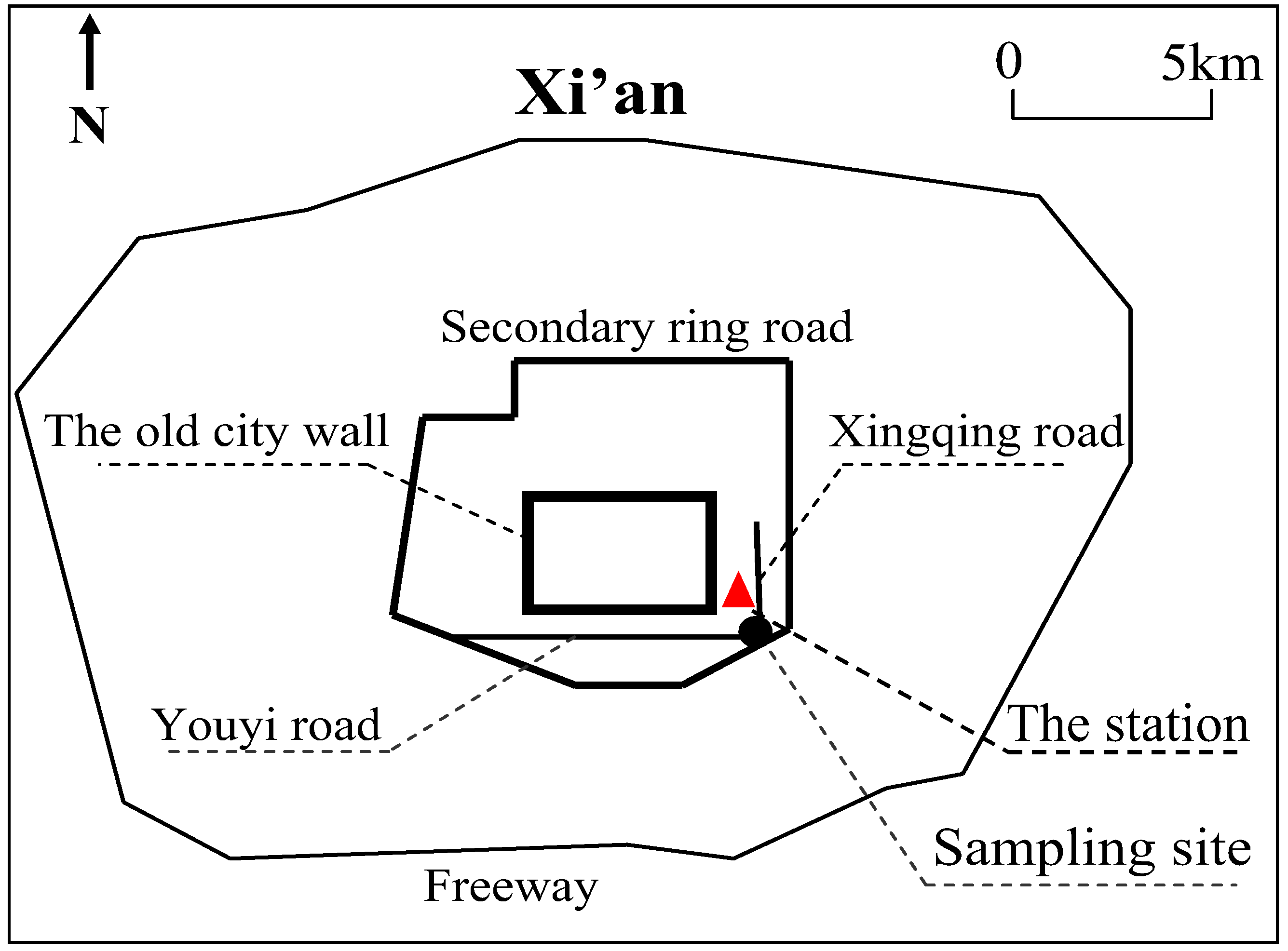
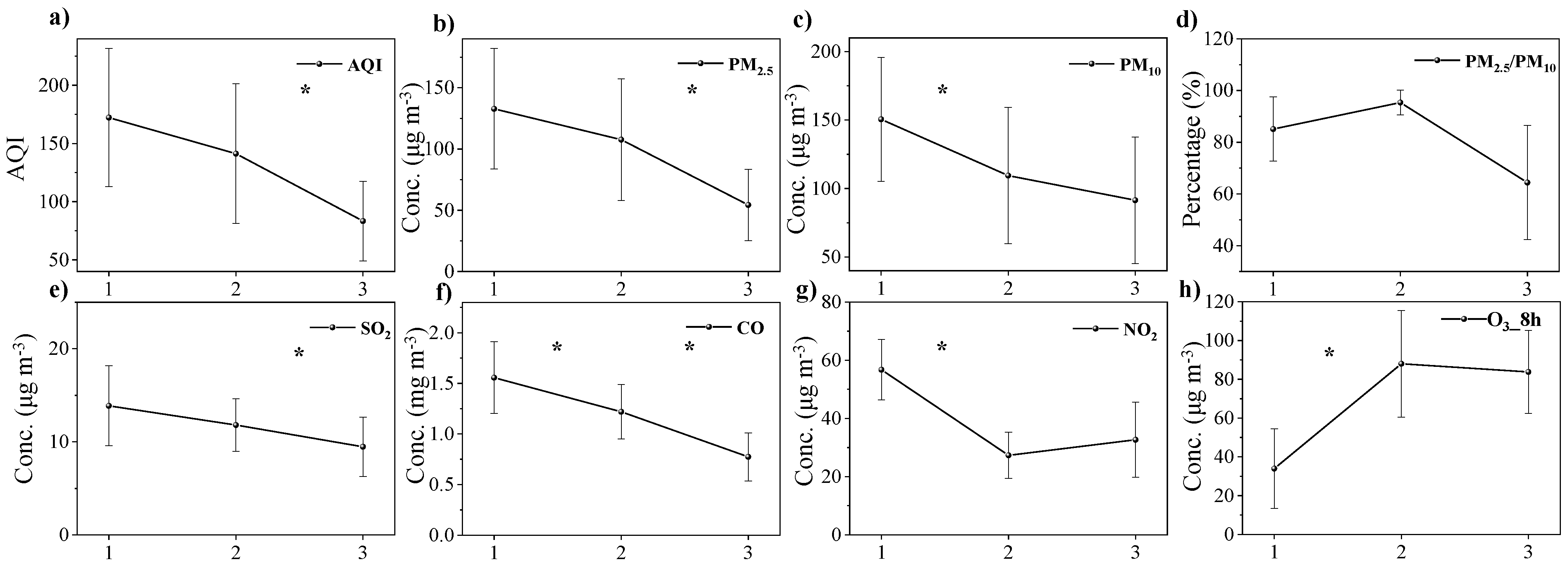
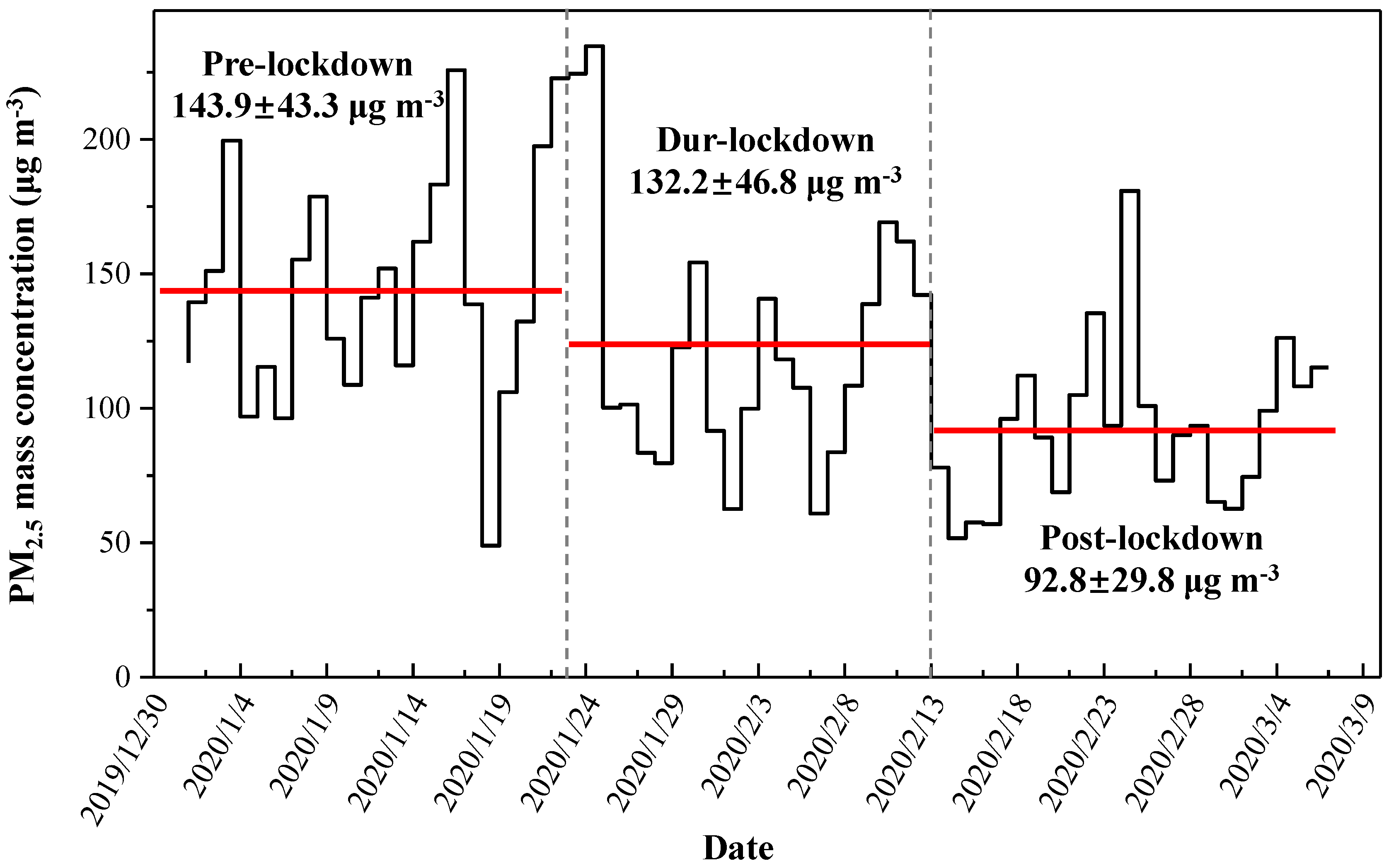
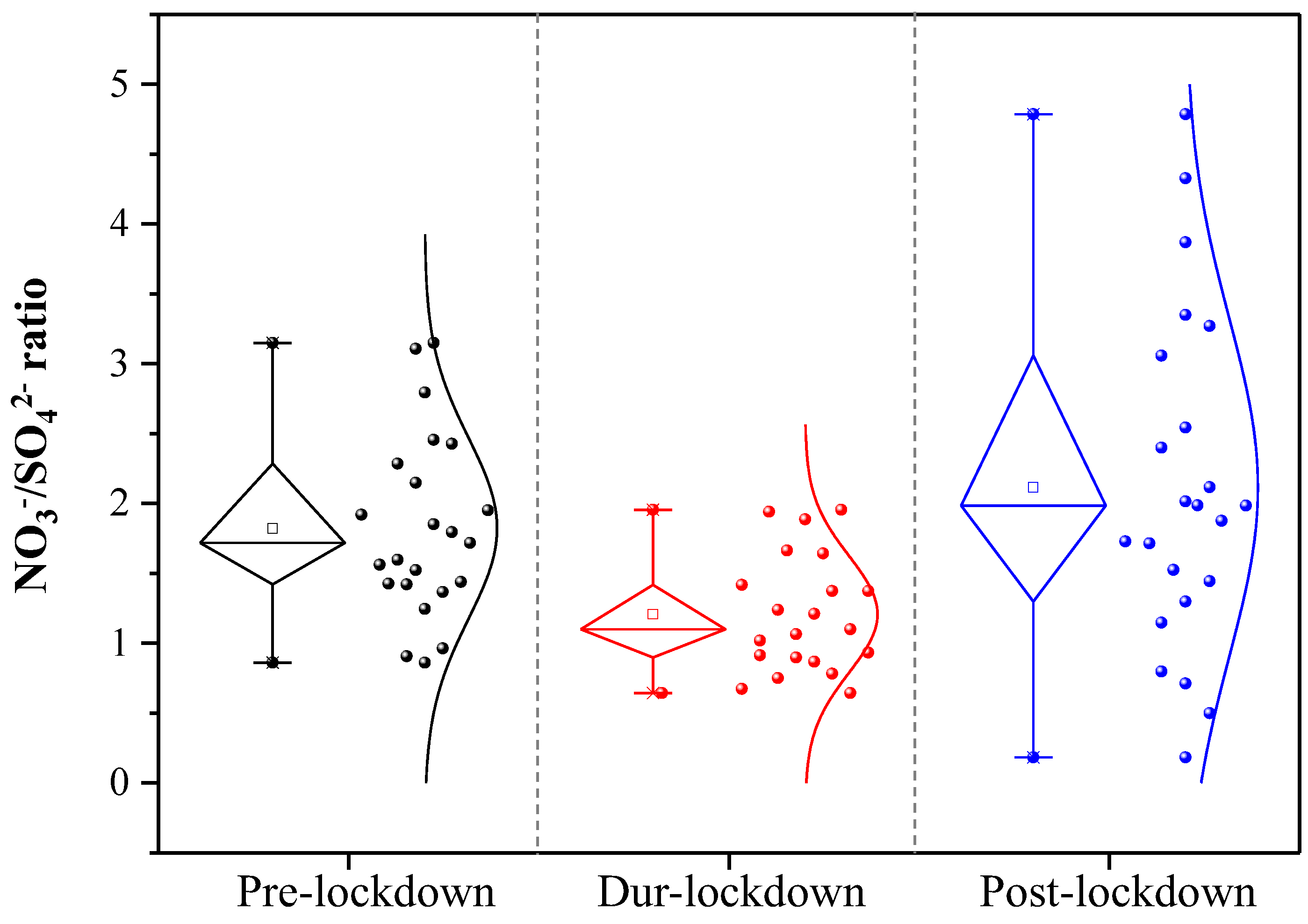

| Temperature (T, °C) | Relative Humidity (RH) | Prevailing Wind Direction (PWD) | Wind Speed (WS, m s−1) | |
|---|---|---|---|---|
| Pre-lockdown | 1.7 ± 1.4 | 62 ± 5% | Northeast | 2.4 ± 1.7 |
| Dur-lockdown | 4.4 ± 2.1 | 59 ± 4% | Northeast | 2.3 ± 1.6 |
| Post-lockdown | 7.6 ± 3.6 | 50 ± 5% | Northeast | 4.5 ± 3.0 |
| TC (μg m−3) | OC (μg m−3) | EC (μg m−3) | OC/EC | |
|---|---|---|---|---|
| (TC/PM2.5) | (OC/PM2.5) | (EC/PM2.5) | ||
| Pre-lockdown | 19.1 ± 7.0 (13.3% ± 2.7%) | 15.2 ± 5.8 (10.6% ± 2.4%) | 3.9 ± 1.3 (2.7% ± 0.4%) | 3.8 ± 0.6 |
| Dur-lockdown | 17.6 ± 7.6 (14.4% ± 4.2%) | 14.6 ± 6.4 (11.9% ± 3.7%) | 3.0 ± 1.3 (2.5% ± 0.6%) | 4.8 ± 0.8 |
| Post-lockdown | 10.8 ± 5.5 (11.5% ± 3.8%) | 8.7 ± 4.5 (9.3% ± 3.2%) | 2.1 ± 1.1 (2.2% ± 0.7%) | 4.4 ± 0.9 |
| Reference | Study Location | Air Pollutants | ||||||
|---|---|---|---|---|---|---|---|---|
| PM2.5 | PM10 | NO2 | SO2 | CO | O3 | Others | ||
| This study | Xi’an, China | −17% | −27% | −52% | −16% | −25% | +160% | WSIs (−16%) |
| Wang et al., 2021 [78] | Suzhou, China | −37.2% | −38.3% | −64.5% | +1.5% | −26.1% | +104.7% | WSIs (−58%) |
| Gao et al., 2021 [79] | Wuhan, Beijing, Shanghai, and Guangzhou, China | −9.4% | −43.0% | −10.9% | ||||
| Tello-Leal et al., 2020 [80] | Victoria, Mexico | −45% | −45% | −47% | ||||
| Wu et al., 2021 [81] | Shanghai, China | −(30–40%) | −(16.4–28.8%) | +(5.7–30.2%) | ||||
| Ding et al., 2021 [82] | Tianjin, China | −22.7% | −17.7% | +3.0% | ||||
| Chu et al., 2021 [83] | Wuhan, China | −35% | −36% | −53% | −10% | −6% | +58% | |
| Wang et al., 2021 [84] | Beijing-Tianjin-Hebei (BTH) and Yangtze River Delta (YRD), China | |||||||
| Bai et al., 2021 [85] | 1388 Monitoring stations nationwide in China | −(30–60%) | ||||||
| Shehzad et al., 2021 [68] | Delhi and Mumbai, India | −42% | −50% | −53% | −41% | −37% | +2.0% | NH3 (−21%) |
| Chatterjee et al., 2021 [86] | Eastern Himalaya, India | NO | ||||||
| OC, EC, OC/EC, TC, SOC | ||||||||
| A et al., 2021 [87] | Eastern Himalaya, India Santiago, Chile | |||||||
| Orak et al., 2021 [88] | All 81 cities of Turkey | −67% | −59% | |||||
| He et al., 2021 [89] | 380 cities across the globe | −16.1% | −45.8% | +5.4% | ||||
| Yadav et al., 2020 [90] | Four megacities, India | −(25–50%) | −(36–50%) | −(60–65%) | ||||
Publisher’s Note: MDPI stays neutral with regard to jurisdictional claims in published maps and institutional affiliations. |
© 2021 by the authors. Licensee MDPI, Basel, Switzerland. This article is an open access article distributed under the terms and conditions of the Creative Commons Attribution (CC BY) license (https://creativecommons.org/licenses/by/4.0/).
Share and Cite
Feng, R.; Xu, H.; Wang, Z.; Gu, Y.; Liu, Z.; Zhang, H.; Zhang, T.; Wang, Q.; Zhang, Q.; Liu, S.; et al. Quantifying Air Pollutant Variations during COVID-19 Lockdown in a Capital City in Northwest China. Atmosphere 2021, 12, 788. https://doi.org/10.3390/atmos12060788
Feng R, Xu H, Wang Z, Gu Y, Liu Z, Zhang H, Zhang T, Wang Q, Zhang Q, Liu S, et al. Quantifying Air Pollutant Variations during COVID-19 Lockdown in a Capital City in Northwest China. Atmosphere. 2021; 12(6):788. https://doi.org/10.3390/atmos12060788
Chicago/Turabian StyleFeng, Rong, Hongmei Xu, Zexuan Wang, Yunxuan Gu, Zhe Liu, Haijing Zhang, Tian Zhang, Qiyuan Wang, Qian Zhang, Suixin Liu, and et al. 2021. "Quantifying Air Pollutant Variations during COVID-19 Lockdown in a Capital City in Northwest China" Atmosphere 12, no. 6: 788. https://doi.org/10.3390/atmos12060788
APA StyleFeng, R., Xu, H., Wang, Z., Gu, Y., Liu, Z., Zhang, H., Zhang, T., Wang, Q., Zhang, Q., Liu, S., Shen, Z., & Wang, Q. (2021). Quantifying Air Pollutant Variations during COVID-19 Lockdown in a Capital City in Northwest China. Atmosphere, 12(6), 788. https://doi.org/10.3390/atmos12060788








